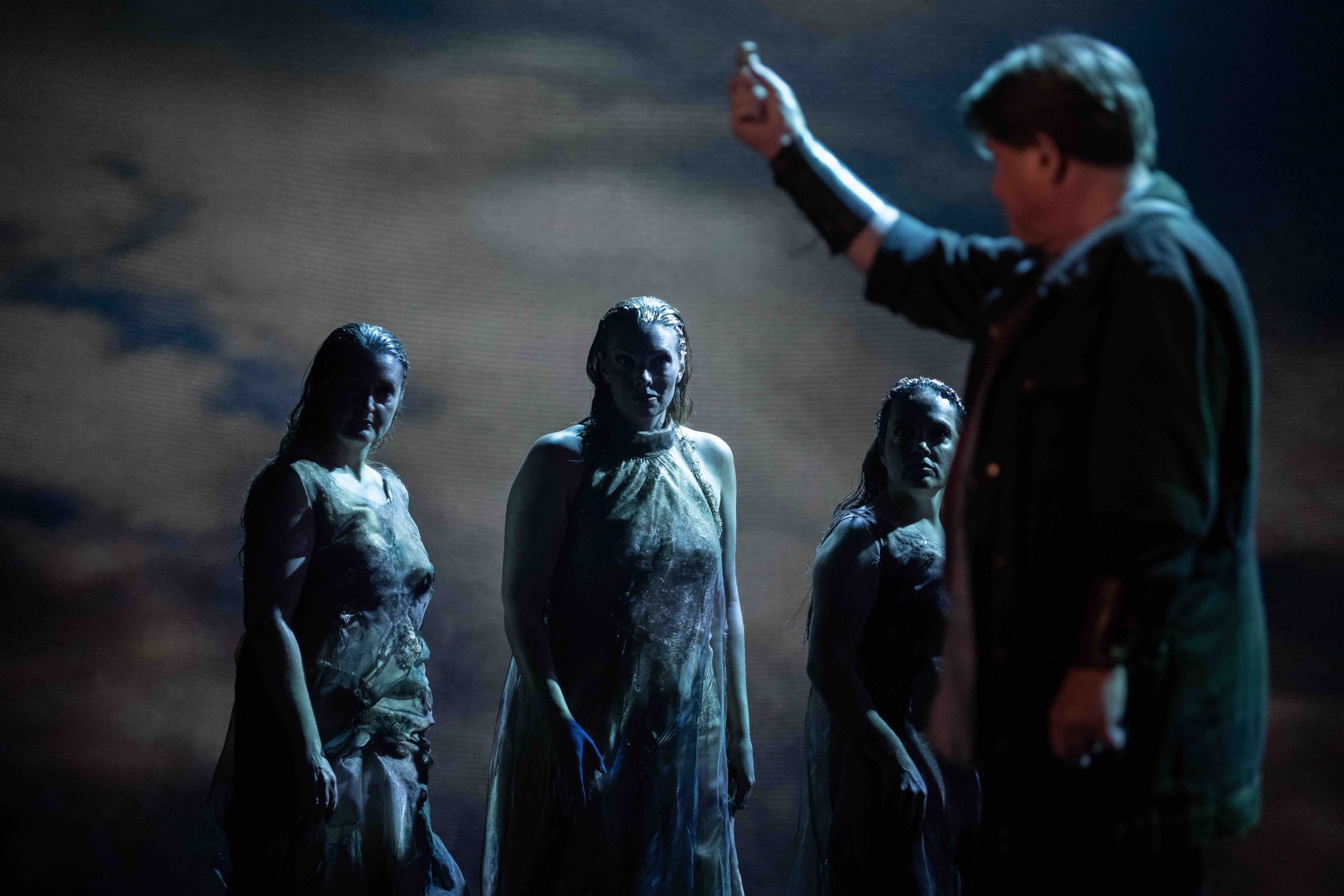
****
One important achievement of Amy Lane’s handling of Götterdämmerung is that it allows the singers and musicians to concentrate their talent and skills on Wagner’s Ring Cycle catharsis without too much over direction. In a confined space it seems sensible to concentrate our focus on the unfolding drama which is all contained in the music.
Admittedly, the already small space of the Longborough theatre is made even tighter with her designer Rhiannon Newman Brown’s generic rocky static set that I believe has been in all three of the staged operas (Walkyrie had to be a concert performance) and a sort of proscenium framing a video projection wall.
Perhaps oddly, however, this final saga has less of theatrical interest than, say, Siegfried, despite ranging from the forests of the Rhine, the river itself with its glorious Rhinemaidens the petty world of the Gibichungs contrasting with the Delphic world of the Norns, fiery mountain crags and ever-present Valhalla.
In terms of drama, it has something for everyone, love, deceit, revenge, murder, guilt, sacrifice, sex, crowd scenes, magic, shapeshifters, blazing inferno, car chases (well, galloping and flying horses). However, much of this is achieved through the ever presence and slightly hypnotic Tim Baxter video and generally sensibly left to the music to create visual as well as audio soundscapes. The players are often reduced to standing and singing at the ever-attentive audience, with explosions of action and stylised acting particularly from our bouncy hero Siegfried and his weak blood brother Gunther and the glorious decomposing Alberich sung by Freddie Tong.





Visually, the most effective scenes are firstly the opening with the Norns and their dark fortune telling and then Siegfried’s delightful final encounter with the sprightly (spritely?) Rhinemaidens. As with the third instalment, Siegfried, the more magical and mysterious the scenes (the Forest Bird in Siegfried comes to mind), the better theyl seem to work in this handling of the epic saga.
What is carried through the operas? Well, writing in a journal (or many journals for the ending), drawing sketches, the maybe late Victorian costumes, guns and rifles along with that sword and hunting horn, lots of black boots, and hugging Lycra for Brunnhilde. Perhaps more will be revealed or partially explained when Walkurie is staged as part of the complete cycle next year. We are, of course, stuck with Emma Ryott’s not particularly inspiring designs apart from the aforementioned Walkyrie gym-ready power dressing. As Waltraute, Catherine Carby is similarly clad as she appeals to her sister to mend her ways. This sketch book / notebook theme comes into its own with Hagen’s drawings now portrait-sized rather than etched in his own book. Brunnhilde also takes up a notebook to place on her dead husband’s chest and the ravens who she sends to Wotan are a page taken from the book.
The number of words given over to intertextual analysis of the Ring and the various stage interpretations defies measure but what here is justified is praise for a gorgeous cast and, of cast, Anthony Negus’s breath-taking attention to the score and what is achieved in this Cotswold’s mini-miracle.
Siegfried, sung by Bradley Daley, and Gunther, Benedict Nelson, are not quite reduced to being each other’s Tweedledum and Tweedledee to Brunnhilde’s Alice (or Hagen’s Queen of Hearts?), although there is magic potions and shape-shifting galore, but they come over as too over-excited in their Bromance. This is all choreographed by the wonderful Hagen from Julian Close, an arch baddie but whose glorious bass has the audience in his hand with no need of that magic potion or other evil crafts. If anything, so strong is Close he vocally overshadows all other male members of the cast.
It is hard to believe Scottish soprano Lee Bissett is the same woman who took part in the BBC operatic TV talent show in Cardiff in 2005 – yes, 18 years ago. Now this fine performer who, along with Close, holds this production together with singing and acting that are perfect for this small auditorium where every facial gesture as well as sung note matters. This is a Wagnerian soprano that is not out of any conventional or expected mould, as a performer and as directed, she is her own woman and that is probably the best lesson from this cycle. Her voice and body lives the role, and her singing brings the final triumph over the manipulations and weaknesses of man and gods.
While the resurrected and reconciled trinity of Wotan, Siegfried and Brunnhilde is possibly a step too far, the closing of the opera with Brunnhilde facing into the audience as the auditorium is bathed in fiery red lights as Valhalla burns is as moving as the silence that falls across the audience.
Yet, as production after production teaches us, it is yet again always the music, the textures and colours eased from the players and enhancing the passion and pain in the singers’ voices, that makes this our own all-consuming, cathartic experience. Faultless? No, but majestic, certainly yes.
The sun shone down on this last of the Cycle and further Götterdämmerung performances are accompanied by a, should we say, lighter programme of works across June, July and into the start of August, Donizetti’s L’Elisir d’Amore, Purcell’s Faery Queen and Monteverdi’s L’Orfeo.
It would be foolhardy not to book now and head to the Cotswolds.
Further performances of Götterdämmerung on 31 May and 2, 4 and 6 June
Main image: Bradley Daley with the Rhinemaidens, Mari Wyn Williams, Rebecca Afonwy-Jones and Katie Stevens
Images: Matthew Williams-Ellis.